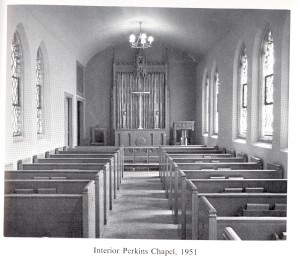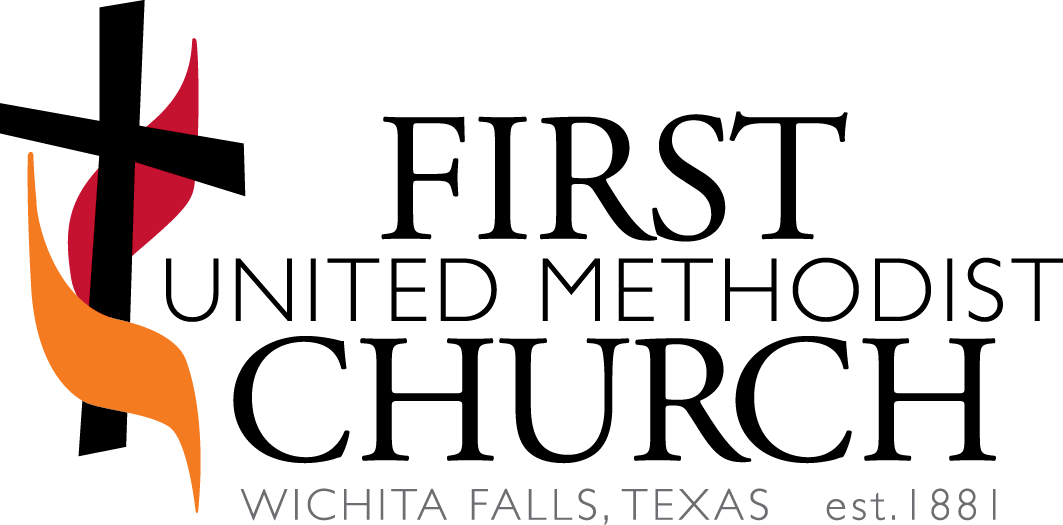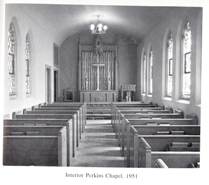Tradition
 During the pastorate of Paul E. Martin (1938-1944), many of our special events had their beginnings. The Perkins Lectures, established in 1943, were his idea. Dr. Roy Smith gave the first lecture. Then working with the choir director Pearl Calhoun Davis, Dr. Martin originated the Christmas Candlelight Service and the Lily Processional at Easter. As early as December 11, 1938, the Methodist Home children in Waco sang for our congregation before taking up the Christmas gift offering. The Home has benefited from the largesse of our church. In the 1940’s, the Wesleyan Service Guild for working women was organized. In 1941, the Soldiers’ Lounge was opened in REC (Recreational) Lobby for the soldiers stationed at Sheppard Field (the forerunner of Sheppard Air Force Base), and Sunday School classes continued to be organized: Keystone Class (1945), Couples Class (1947), and Winsome Class (1950). On September 17, 1948, the Associate Pastor, the Rev. Clarence Collins announced the largest Sunday School attendance to that day with 1811 people. In 1948, a Folk Festival, which was to become today’s Summer Youth Musical, was held. Methodist Sunday School enrollment in Texas peaked in 1959-60 but has declined ever since. Our church Sunday School has followed this pattern.
During the pastorate of Paul E. Martin (1938-1944), many of our special events had their beginnings. The Perkins Lectures, established in 1943, were his idea. Dr. Roy Smith gave the first lecture. Then working with the choir director Pearl Calhoun Davis, Dr. Martin originated the Christmas Candlelight Service and the Lily Processional at Easter. As early as December 11, 1938, the Methodist Home children in Waco sang for our congregation before taking up the Christmas gift offering. The Home has benefited from the largesse of our church. In the 1940’s, the Wesleyan Service Guild for working women was organized. In 1941, the Soldiers’ Lounge was opened in REC (Recreational) Lobby for the soldiers stationed at Sheppard Field (the forerunner of Sheppard Air Force Base), and Sunday School classes continued to be organized: Keystone Class (1945), Couples Class (1947), and Winsome Class (1950). On September 17, 1948, the Associate Pastor, the Rev. Clarence Collins announced the largest Sunday School attendance to that day with 1811 people. In 1948, a Folk Festival, which was to become today’s Summer Youth Musical, was held. Methodist Sunday School enrollment in Texas peaked in 1959-60 but has declined ever since. Our church Sunday School has followed this pattern.
 Alfred H. Freeman (1949-1956) was an enterprising leader and a builder. The fifth parsonage, our present one, was built in 1951. The year 1951 also saw the completion of the Perkins Chapel, which had been a shell until that time. The first remodeling of our church building soon followed the completion of the chapel. It began with Nita Akin’s promotion of rebuilding the organ and soon encompassed much of the building. In June of 1953, the project proceeded with Clyde Murph, construction; Bennet & Crittenden of Dallas, architects (who also designed the Perkins Chapel of our church); and Charles Prothro and George Adams, building committee co-chairs. It included the chancel remodeling, replacing the 1940 air-conditioning equipment, air-conditioning the Education Building, the building of Fellowship Hall above REC Lobby, and the joining of the main church building and Education Building with the addition of new offices. The chancel was centered with choir loft on both sides to seat 70. The old communion table was built into the new altar under the rose window. At the same time, the Aeolian-Skinner Organ Company of Boston, Massachusetts rebuilt the Reuter organ (Click here for more about the organ).
Alfred H. Freeman (1949-1956) was an enterprising leader and a builder. The fifth parsonage, our present one, was built in 1951. The year 1951 also saw the completion of the Perkins Chapel, which had been a shell until that time. The first remodeling of our church building soon followed the completion of the chapel. It began with Nita Akin’s promotion of rebuilding the organ and soon encompassed much of the building. In June of 1953, the project proceeded with Clyde Murph, construction; Bennet & Crittenden of Dallas, architects (who also designed the Perkins Chapel of our church); and Charles Prothro and George Adams, building committee co-chairs. It included the chancel remodeling, replacing the 1940 air-conditioning equipment, air-conditioning the Education Building, the building of Fellowship Hall above REC Lobby, and the joining of the main church building and Education Building with the addition of new offices. The chancel was centered with choir loft on both sides to seat 70. The old communion table was built into the new altar under the rose window. At the same time, the Aeolian-Skinner Organ Company of Boston, Massachusetts rebuilt the Reuter organ (Click here for more about the organ).
In 1954, Dr. Leslie Weatherhead of City Temple, London, came to Wichita Falls as our Perkins Lecturer. In a series of ten lectures, in spite of rain and having medical treatment, he packed the house. Dr. Weatherhead has been our most memorable lecturer.
In 1956, the church membership reached its all-time peak of 3624 members.
The Scout Hut, which was on loan to Interfaith Ministries from 1984-2007, was built in 1964. The School for Little People, which has contributed to our entire city, opened in 1965. The youth remained active, and the first ICYE (International Christian Youth Exchange) student, David Coward, was sent to live in Germany, and Christina Zogg of Switzerland spent a year with us.
Outside lighting was installed in 1968. Other additions have been an ever-growing parking lot and the Park across the street that is mostly used by the children.
From the beginning this has been a mission-minded church. Through the years, among other projects, we have supported a hospital in Call Field. Missionary projects include supporting a rural school in Brazil, Finis and Shirley Jeffrey in Korea and Ecuador, and H. T. and Alice Maclin in Africa. We took in a refugee Romanian family and the Phuongs from Vietnam. For a number of years beginning in 1959 and through the tornado we helped both physically and monetarily El Buen Pastore Church in Wichita Falls. In 1968, a Festival of Missions was held with Rev. and Mrs. Kenneth McIntosh. In recent years, food boxes have gone to Russia, North Korea, and Bosnia. The youth repainted a home on Polk Street for a single mother with two teenage boys.
Changes in the Sanctuary continued. We had two center aisles in the Sanctuary until 1966 when we changed into only one center aisle, just as many other churches were doing. The beige carpet with black flecks that the Woman’s Society had given the church when it was first built was replaced with a red carpet. Marvin McCullough was meeting with the Building Committee one evening when the color of the carpet was being discussed. While everyone on the committee liked the red color, Mr. McCullough objected to it. As Chairman of the Official Board (as it was then called), his opinion was very important. However, the next morning after a visit with his wife, he had completely changed his mind!
Walter Underwood (1967-1972) was a person who not only could relate to people but also could inspire us. During the 1950’s, the revivals, though not annual as in the early days, were held periodically with G. Ernest Thompson and Gaston Foote. In the 1960’s, Pastor Underwood brought revivalists, Charles Allen and later Robert E. Goodrich with a singer and choir director, Bill Mann. However, Richard Freeman, son of our former minister, Alfred H. Freeman, held our last revival from April 29 to May 1, 1990. Thus ended a long and important tradition in our church.
From November 14 to 21 in 1971, FAIR (Festival of the Arts in Religion) was put on for the enjoyment of the entire city. It included an exhibit of etchings and lithographs by Marc Chagall, Henry Pearson, George Henry Rouault, Ben Shahn, and Sarai Sherman. The exhibit was held in Fellowship Hall and opened everyday until nine o’clock in the evening during the festival. Docents were trained to tell about these art works on loan from Bridwell Library at Perkins School of Theology, Southern Methodist University. On Tuesday night, November 16, Rabbi Levi Olan gave a lecture on “The Arts and the Spirit of Man.” The famous Lab Band from North Texas State University performed in a Religious Jazz Concert on the opening night in the Sanctuary. We also had a program of Bible Reading with Jazz Interpretation and a performance of Andrew Lloyd Webber’s Jesus Christ Superstar both in the Sanctuary.
Bruce Weaver (1972-1981) was an initiator who brought about things to move the church forward. It was he who was responsible for celebrating important dates in our church’s history. It was he who facilitated the forming of the Heritage Committee and the redoing of the Narthex with its stained glass window. In 1974, six women were elected to the Class of 1977, the first women on the Board as full members, and it was he who suggested that a woman be chairman of the Administrative Board in 1980.
A devastating tornado hit Wichita Falls on Tuesday, April 10, 1979. Forty-five people were killed, five from our church. Nine-hundred families, one out of six in the city and 150 in our church, were left homeless or with heavily damaged homes. Disaster aid to our members from the church included a small monetary gift to those needing it. The following Sunday was Easter, and a union service was held in our Sanctuary. Between 1000 and 1200 people attended each of two worship services. To aid people hurt by the tornado, Pastor Weaver then organized Interfaith Disaster Services, which later became Interfaith Ministries.
This period of time was rich in the special events so dear to this congregation. On July 4, 1976, a bicentennial worship service was held. On September 24, 1978, we celebrated the 50th anniversary of the Sanctuary followed by the dedication of the Paul E. Martin Narthex on September 28. The two other major restorations have been the renovation of the complete facility in 1977-78 and the multiple repairs on the physical plant and the major organ repair in 1986-89. In 1981, we celebrated the centennial of the organization of our church with several events, one each Sunday during the month of March, including lunch on the grounds and a pageant.
1984 was an important year for our church. We observed the bicentennial celebration of Methodism in March. On April 4, our building was awarded a Texas Historical Marker; and on May 15, there was a service to bestow the Local Landmark designation. In October, we dedicated a needlepoint dossal cloth for the Chapel, stitched by members of the church over a period of nine years.
Meantime, our church members have served the Methodist Church at large in numerous capacities as delegates to Annual, Jurisdictional, and General Conferences, and as members of boards on various levels, including the World Methodist Council. Various boards of colleges and universities as well as national Boards of the United Methodist Church have had members from our church.
Our church has had a proud history. Two pastors have become bishops. In July of 1944, Paul E. Martin was elected bishop from our church; and in July of 1985, Walter Underwood was elected bishop while serving at St. Luke’s United Methodist Church in Houston, Texas.
| Read more of our history here: | ||||
| Part I | Part II | Part III | Part IV | Part V |
The history pages above were written by Elizabeth Prothro and Kiyo Watanabe. It is our hope that these documents will help you to learn not only the church history but also how people of the church have put their enormous effort with faith into building this legacy of the church through the years. We also hope you will be as proud of being a part of our church’s legend as we are. These were also published as a book titled Building Our Legacy in December of 1999.

